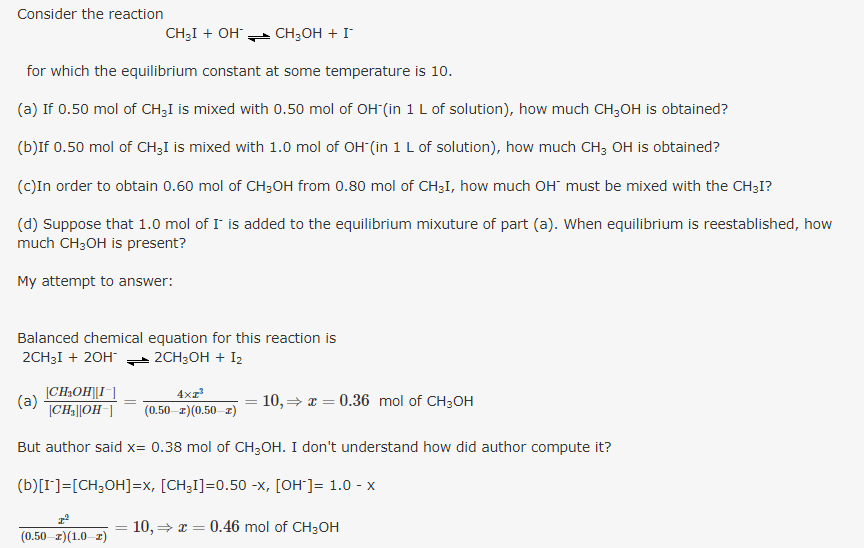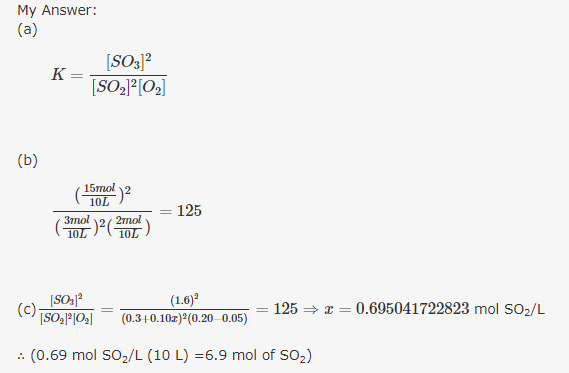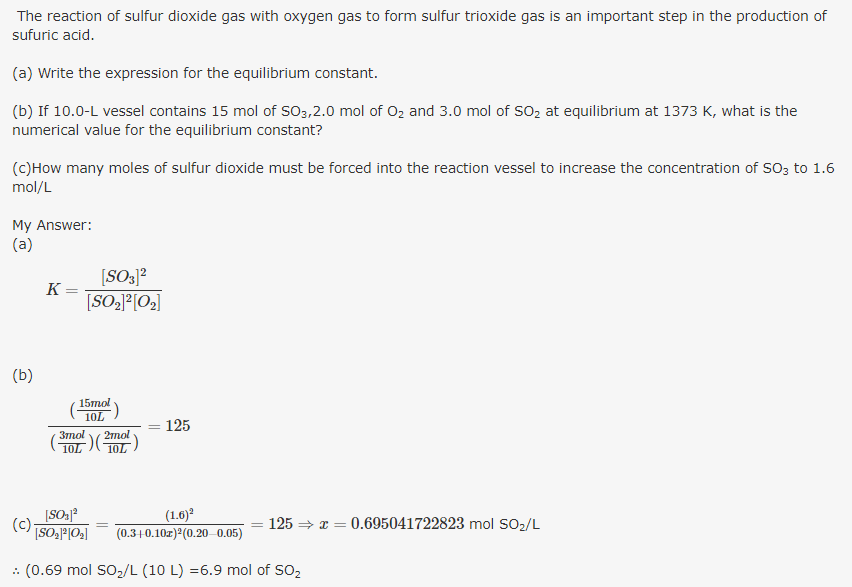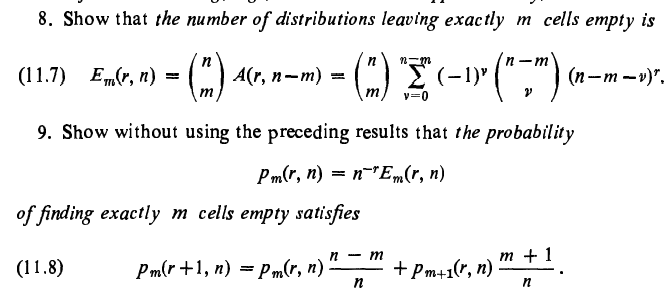
Everything posted by Dhamnekar Win,odd
-
Equilibrium between [math]CH_3OH[/math] and [math]CH_3I, OH^-[/math]
I am working on question (d) for answering it. Any chemistry help will be accepted. Do you know the correct answer for question(d)?
-
Equilibrium between [math]SO_3 [/math](product) and [math]SO_2,O_2[/math] (reactants)
Whichever and whatever computations of Kc you use, eventually, final answer would be 0.17 mol /L SO2 should be added to the existing 0.2 mol/L SO2.
-
Equilibrium between [math]SO_3 [/math](product) and [math]SO_2,O_2[/math] (reactants)
My corrected answer to (c) is [math] \frac{[1.6]^2}{[ 0.3 - 0.1 + x]^2 [0.20 - 0.05]}=125 \Rightarrow x = 0.17 [/math] mol SO2. ∴(0.17 mol SO2/L) (10 L)= 1.7 mol of SO2.
-
Badges in Scienceforums.net
Please visit here
-
Equilibrium between [math]SO_3 [/math](product) and [math]SO_2,O_2[/math] (reactants)
Yes, I forgot to square the concentration of SO3 in the numerator and the concentration of SO2 in the denominator of the fraction in (b). But R.H.S. 125 is correctly computed. But what is your opinion about my answer to (c)?
-
Badges in Scienceforums.net
Are there any badges here for members?
-
Equilibrium between [math]SO_3 [/math](product) and [math]SO_2,O_2[/math] (reactants)
-
Choice, Chance and Sensible Logic
SOLVED
-
Choice, Chance and Sensible Logic
a) In how many parts, we can divide an infinite plane by n straight lines of which no two lines are parallel and no three lines are concurrent? b) In how many parts, we can divide an infinite space by n planes of which no four planes meets in a point and no two planes are parallel? How to answer both these questions? What are the answers to these questions? I am working on these questions. Any math help, problem solving hint will be accepted.
-
Elements of Combinatorial Analysis
This problem is " SOLVED"
-
Elements of Combinatorial Analysis
Thanks for your reply. I am working on the question 9 and statement in your reply to prove it practically as well as theoretically.
-
Elements of Combinatorial Analysis
-
Elements of Combinatorial Analysis
I tag this question as "SOLVED"
-
Why are two answers different using the two equivalent formulas in combinatorics ?
So, Eventually I did it. Using formula (1) we get [math] A(4,2)= \displaystyle\sum_{k=1}^{3}\binom{4}{k}\cdot \displaystyle\sum_{v=0}^{1}(-1)^v\cdot \binom{1}{v}\cdot (1-v)^{4-k}=14[/math] Using formula (1)we get[math] A(4,3)=\displaystyle\sum_{k=1}^{2}\binom{4}{k}\cdot\displaystyle\sum_{v=0}^{2}(-1)^v\cdot \binom{2}{v} \cdot (2-v)^{4-k}=36[/math] Using formula (2) we get [math]A(4,2)=\displaystyle\sum_{v=0}^{2}(-1)^v \cdot \binom{2}{v}\cdot (2-v)^{4}=14[/math] as expected Using formula (2) we get [math] A(4,3)=\displaystyle\sum_{v=0}^{3}(-1)^v\cdot \binom{3}{v}\cdot(3-v)^{4}=36 [/math] as expected. Thanks for your guidance.
-
Why are two answers different using the two equivalent formulas in combinatorics ?
But as per formula (2)r=4 and k=1 , which results in [math] (-1)^0 \cdot \binom{2}{0}\cdot(2-v)^3[/math] Formula (2) = [math]A(r-k,n) =\displaystyle\sum_{v=0}^{n}(-1)^v\binom{n}{v}(n-v)^{r-k}[/math]
-
Why are two answers different using the two equivalent formulas in combinatorics ?
So, for [math] k=1, A(3,2)=(-1)^0 \cdot \binom{2}{0} \cdot (2-v)^{4-1=3}[/math] Is this correct?
-
Why are two answers different using the two equivalent formulas in combinatorics ?
This answer refers to r=4 objects and n=2 cells question. We know A(r,n) =A(4,2)= 14 , My answer to A(r-k,n))=A(4-k, 2)=7 Is this answer correct?
-
Why are two answers different using the two equivalent formulas in combinatorics ?
[math]A(4-k,2)= (-1)^0 \cdot \binom{2}{0} \cdot(2-0)^{4-1} + (-1)^1\cdot \binom{2}{1} \cdot(2-1)^{4-2} = 8-1 =7[/math] Is this answer correct?
-
Why are two answers different using the two equivalent formulas in combinatorics ?
My attempt to derive general formula for A(r,n) =[math]\displaystyle\sum_{k=1}^{r-1}\binom{r-1}{k}\cdot A(r-k-1,n-1)[/math]
-
Why are two answers different using the two equivalent formulas in combinatorics ?
Author said to change order of summation and use binomial formula to express A(r, n+1) as the difference of two simple sums. So, I did it. As regards derivation of equation(1) using combinatorial arguments, author didn't write anything about that in his book. So, I don't know how to derive it.
-
Why are two answers different using the two equivalent formulas in combinatorics ?
If I put r=2, I get answer=3. If I put 4=3, I get answer=7. If I put r=4, I get answer=15. Now what is your suggestion?
-
Why are two answers different using the two equivalent formulas in combinatorics ?
I changed the order of summation and the expressed A(4,1+1=2)as the difference of two simple sums [math]\displaystyle\sum_{k=1}^{4}\binom{4}{k} \cdot\displaystyle\sum_{v=0}^{1}(-1)^v\cdot \binom{1}{v}\cdot(1-v)^{4-k}-\displaystyle\sum_{v=0}^{1}(-1)^v\cdot \binom{1}{v}\cdot(1-v)[/math] Now, what we can do?
-
Why are two answers different using the two equivalent formulas in combinatorics ?
That's what the author want to suggest. How can we change the order of summations in the answer which we got using formula (1) so that we get the answer 14?
-
Why are two answers different using the two equivalent formulas in combinatorics ?
Using formula (2), we get [math] A(4,2)= \displaystyle\sum_{v=0}^{2}(-1)^v\cdot \binom{2}{v}(2-v)^4=14[/math] Using formula (1), we get [math]A(4,2)=\displaystyle\sum_{k=1}^{4} \binom{4}{k}\cdot\displaystyle\sum_{v=0}^{1}(-1)^v \binom{1}{v}(1-v)^{4-k}=15[/math] Now, how can we remove the difference of one between these two answers?
-
Why are two answers different using the two equivalent formulas in combinatorics ?
I am trying to derive the formula (1) by combinatorial argument, but I didn't succeed. My difficulty to understand the Author's suggestions: 1) This is a classical occupancy problem. Assuming that all [math]n^r[/math] possible placements are equally probable, the probability to obtain the given occupancy numbers [math]r_1,...r_n[/math] equals [math] \frac{r!}{r_1! r_2!...r_n!} n^{-r}[/math] Here, we are concerned with only indistinguishable particles or objects. In Physics, this probability is known as Maxwell-Boltzmann statistics. Now, suppose, we have to put 4 objects in 2 cells. The number of distinguishable distributions of 4 identical objects into 2 cells is [math]\binom{3}{1}=3[/math].|***|*|, |*|***| or |**|**| But if we use formula (2) we get 14 as answer |**|**|, |**|**|, |**|**|, |**|**|, |**|**|, |**|**|, |***|*|,|***|*|,|***|*|, |***|*|, |*|***|, |*|***|, |*|***|, |*|***| . In case of A,B,C,D objects, we get |AB|CD|,|AC|BD|,|AD|BC|,|BC|AD|,|BD|AC|,|CD|AC|,|ABC|D|,|ACD|B|,|ABD|C|,|BCD|A|,|A|BCD|,|B|ACD|,|C|ABD|,|D|ABC| Using formula (1), we get [math]A(4,3)=\displaystyle\sum_{k=1}^{4}\binom{4}{k}*\displaystyle\sum_{v=0}^{2}(-1)^v*\binom{2}{v}*(2-v)^{4-k}=35[/math] I think this answer assumes distinguishable cells as well as objects. Now I don't understand , on what basis , we can say that this formula is derived assuming indistinguishable objects?





